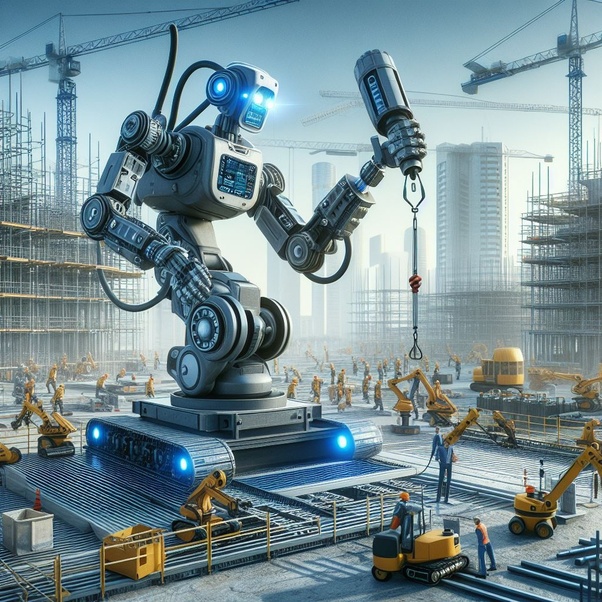In recent years, the construction industry has witnessed a paradigm shift with the integration of robotics. From automated machinery to semi-automated devices, robotics is revolutionizing the way buildings are designed, constructed, and maintained. In this article, we explore the role of robotics in construction, examining both automated and semi-automated devices, their applications, benefits, challenges, and the future of construction in the era of automation.
I. Introduction to Robotics in Construction
Traditionally, construction has been a labor-intensive and time-consuming process, prone to errors and safety risks. However, the advent of robotics has ushered in a new era of efficiency, precision, and safety. Robotics in construction encompasses a wide range of devices, from autonomous drones and excavators to semi-automated bricklaying robots and 3D printers. These technologies aim to streamline construction processes, improve productivity, and enhance the quality of built structures.
II. Automated Devices in Construction
- Autonomous Excavators: Autonomous excavators equipped with sensors and GPS technology can perform excavation tasks with precision and efficiency. These robotic machines can navigate construction sites, dig trenches, and move earth, reducing the need for manual labor and enhancing safety.
- Drones for Site Monitoring: Drones equipped with cameras and sensors are used for site surveying, progress monitoring, and aerial inspections. They provide real-time aerial footage of construction sites, enabling project managers to identify potential issues, track progress, and make informed decisions.
- Robotic 3D Printers: Robotic 3D printers are revolutionizing building construction by enabling the rapid prototyping and fabrication of complex structures. These printers use additive manufacturing techniques to layer construction materials such as concrete or plastic, creating customized components and entire buildings with unprecedented speed and precision.
- Automated Bricklaying Robots: Automated bricklaying robots utilize robotic arms and computer vision systems to lay bricks accurately and efficiently. These robots can work continuously without fatigue, reducing labor costs and speeding up the construction process while maintaining high-quality standards.
- Robotic Welding Systems: Robotic welding systems are employed in structural steel fabrication, enabling precise and consistent welding of steel components. These robots enhance productivity, reduce waste, and improve weld quality compared to manual welding methods.
III. Semi-Automated Devices in Construction
- Assistive Exoskeletons: Assistive exoskeletons are wearable devices designed to augment the strength and endurance of construction workers. These exoskeletons reduce the risk of musculoskeletal injuries and fatigue by providing support to the wearer's muscles and joints during lifting and repetitive tasks.
- Semi-Automated Cranes: Semi-automated cranes equipped with sensors and control systems assist crane operators in lifting and positioning heavy loads with precision and safety. These cranes enhance productivity and reduce the risk of accidents by incorporating features such as collision avoidance and load monitoring.
- Robotic Demolition Equipment: Robotic demolition equipment is used for selective demolition and dismantling of structures in constrained or hazardous environments. These robots are equipped with hydraulic attachments and remote control systems, allowing operators to demolish buildings with precision while minimizing noise, dust, and safety risks.
- Semi-Automated Prefabrication Systems: Semi-automated prefabrication systems use robotic arms and assembly line techniques to fabricate building components off-site. These systems increase production efficiency, quality control, and customization options while reducing on-site construction time and waste.
- Semi-Automated Masonry Systems: Semi-automated masonry systems combine robotic assistance with human craftsmanship to improve the speed and accuracy of bricklaying and masonry work. These systems utilize robotic arms to assist workers in lifting and placing heavy materials, reducing physical strain and increasing productivity.
IV. Benefits of Robotics in Construction
- Increased Productivity: Robotics in construction streamline processes, reduce labor requirements, and accelerate project timelines, leading to greater overall productivity.
- Enhanced Safety: Automated and semi-automated devices minimize the risk of accidents and injuries by replacing hazardous manual tasks with robotic operations.
- Improved Quality: Robotics ensure precision and consistency in construction tasks, resulting in higher quality structures with fewer defects.
- Cost Savings: While the initial investment in robotics may be significant, the long-term cost savings from improved efficiency, reduced labor costs, and minimized rework justify the expense.
- Environmental Sustainability: Robotics in construction optimize resource utilization, reduce material waste, and minimize environmental impact, contributing to sustainable building practices.
V. Challenges and Considerations
Despite the numerous benefits, robotics in construction also present challenges that must be addressed:
- Cost and Accessibility: The upfront cost of robotics technology may be prohibitive for smaller construction firms, limiting access to these innovations.
- Integration and Compatibility: Integrating robotics into existing construction workflows and infrastructure requires careful planning and consideration to ensure compatibility and efficiency.
- Skills and Training: Construction workers need training to operate and maintain robotic devices effectively, highlighting the importance of education and upskilling initiatives.
- Regulatory and Safety Compliance: Robotics in construction must adhere to safety regulations and standards to mitigate risks and ensure worker and public safety.
- Ethical Considerations: As automation displaces traditional construction jobs, ethical considerations arise concerning job security, worker rights, and equitable access to employment opportunities.
VI. Future Outlook
The future of construction lies in the continued advancement and adoption of robotics technology. As robotics become more sophisticated, affordable, and accessible, their integration into construction processes will become increasingly commonplace. The construction industry will benefit from improved efficiency, safety, and sustainability, ushering in a new era of innovation and progress.
VII. Conclusion
Robotics in construction represent a transformative force that is reshaping the way buildings are designed, constructed, and maintained. From automated machinery to semi-automated devices, robotics offer numerous benefits, including increased productivity, enhanced safety, and improved quality. However, realizing the full potential of robotics in construction requires addressing challenges related to cost, integration, skills, regulation, and ethics. By overcoming these challenges and embracing the opportunities presented by robotics technology, the construction industry can unlock new levels of efficiency, innovation, and sustainability in the built environment.
#RoboticsInConstruction #AutomatedDevices #SemiAutomatedDevices #ConstructionTechnology #Innovation #Efficiency #Precision #Safety #RoboticArms #DronesInConstruction #AutonomousVehicles #RoboticExoskeletons #3DPrinting #ConstructionIndustry #FutureTech #DigitalTransformation #WorkplaceSafety #Productivity #BuildingTheFuture #7447253589 #amoltechnicalguru

